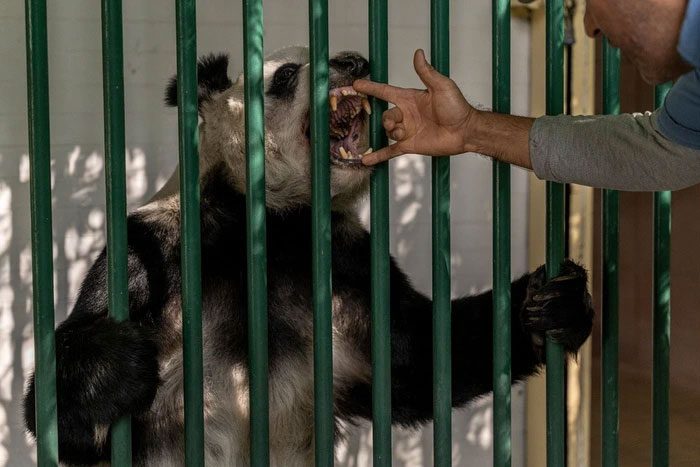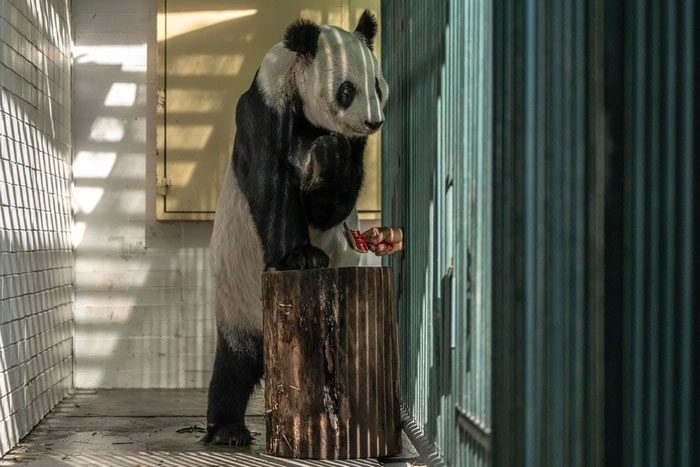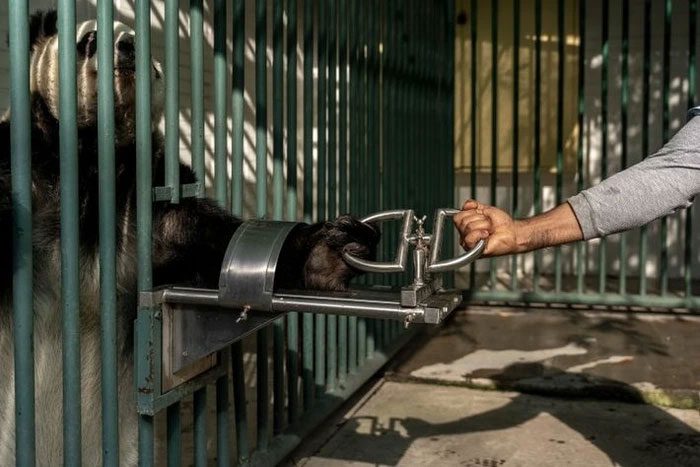Xin Xin is the only remaining member of a panda family originating from two giant pandas gifted by China to Mexico in the 1970s and 1980s.
Xin Xin is currently residing at Chapultepec Zoo. This is one of two zoos that house pandas without direct oversight from China. However, the panda population in Mexico may come to an end when Xin Xin passes away. It could mark the end of pandas in Latin America if the Mexican government “backs down” on the price of “borrowing” another replacement panda.

Xin Xin currently lives at Chapultepec Zoo.
Xin Xin is the granddaughter of the panda pair Pe Pe and Ying Ying, who arrived at Chapultepec Zoo in Mexico in 1975. They were part of China’s “panda diplomacy” policy, a period during which these charming animals were gifted to countries around the world.
Specifically, in the late 1950s, China often gifted giant pandas to nations as a symbol of friendship and diplomatic alliance. This practice dates back to the 7th century when Empress Wu Zetian sent two pandas to Japan.
In 1984, China ended its panda gifting program, shifting to a policy of “borrowing” for a term of 10 to 15 years at a high cost. This meant that zoos would have to pay fees of up to $1 million annually for each pair of pandas, and any cubs born overseas would be considered the property of China and must be returned. According to AP, this policy was enacted to support the conservation of the giant panda species in China.

Panda family tree of pandas raised in Mexico since 1974, starting with Pe Pe and Ying Ying.
Xin Xin has another relative, a panda named Shuan Shuan, who passed away at the age of 35. In 2022, Xin Xin became the last panda at the zoo.
After Shuan Shuan’s death, Mexican officials began talks with the Chinese ambassador. The Mexican government appears reluctant to agree to the rental price proposed by China. “There will certainly have to be another deal, but it will depend a lot on the willingness and needs of both countries,” said Fernando Gual, director of the Mexico City Zoo and Wildlife Conservation.
The Lonely Life of a Forgotten Panda
While authorities seek solutions, Xin Xin’s welfare has been largely forgotten. Everyday, this panda spends her time relaxing on a hammock and quietly wandering around her enclosure in search of bamboo. A panda can eat bamboo up to 15% of its body weight each day. Xin Xin has no relatives or friends left; she resides alone in her zoo enclosure.
In recent years, Mexico City has gradually developed into a hub for tourism and entertainment with many major concerts, racing events, and the upcoming World Cup event taking place in 2026. This is why Xin Xin is increasingly overlooked.



Xin Xin is cared for daily by zoo staff.
Looking at Xin Xin, Fernando Gual smiles as he recalls the morning of July 1, 1990, when her mother, Tohui, surprised everyone at the zoo by giving birth to a tiny panda weighing just 0.11 kg. She was named Xin Xin.
“You can’t help but become attached to these adorable animals,” Fernando Gual said. Tohui was the second panda ever born outside of China and the first to survive infancy until the age of 12. Pop star Yuri released a song expressing the pride and excitement of the people of Mexico City at that time.
The lifespan of giant pandas in the wild is about 15 years, but in captivity, they can live up to 38 years. After decades of conservation efforts and research on captive conditions, scientists have saved giant pandas from extinction risk, increasing their population from fewer than 1,000 individuals to over 1,800 in the wild and in captivity.
Mexico’s notable success in raising Xin Xin has made it one of two zoos that implement a panda program outside of China’s control.
Eight pandas have been born in Mexico, five of which survived to adulthood. Many decades of research at Chapultepec Zoo have provided extensive knowledge, as well as genetic material – frozen sperm and ovarian tissue – that scientists hope will allow them to continue supporting panda conservation even after Xin Xin is gone.
Carlos Cerda Dueñas, a researcher at Monterrey Institute of Technology, who has studied panda diplomacy policy, stated that Mexico’s strategic importance could encourage China to negotiate a deal.
China temporarily suspended its panda loan program for a while due to the Covid-19 pandemic, but it has recently resumed, sending a pair of pandas to the host nation of the 2022 World Cup, Qatar.
At Chapultepec Zoo, there is a panda museum showcasing photos of the animals over the years, their paw prints in plaster, bits of panda fur, and dozens of drawings from children. A piñata (a figure made from materials like paper, ceramics, cardboard, etc.) from Shuan Shuan’s last birthday is also displayed there.
A Valuable Existence
On a day at the end of 2022, Juan Vicente Araya (from Costa Rica) and his family were thrilled to see Xin Xin in person.
“When we decided to travel to Mexico, my children, from the oldest to the youngest, all wished to see a panda,” Araya said while rubbing the head of his young son who was playing with a stuffed panda. It was a gift his parents bought for him during the visit.
Araya, who works for an American company, mentioned that the first thing his group of family and friends did upon arriving in Mexico City was to head straight to the zoo to meet Xin Xin.
He said, “In Latin America, we don’t have many opportunities to see a panda. It was really worth the trip from Costa Rica to see Xin Xin in person. We were very eager to meet her.”


















































